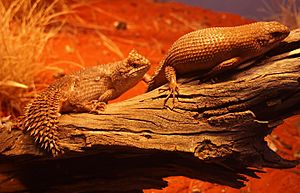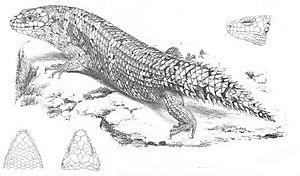Egernia facts for kids
Quick facts for kids Egernia |
|
|---|---|
 |
|
| Stokes's skink, (Egernia stokesii), a small type of Egernia | |
| Scientific classification |
|
| Kingdom: | Animalia |
| Phylum: | Chordata |
| Class: | Reptilia |
| Order: | Squamata |
| Family: | Scincidae |
| Subfamily: | Egerniinae |
| Genus: | Egernia Gray, 1832 |
| Species | |
|
See text |
|
| Synonyms | |
|
Contundo Wells & Wellington, 1984 |
|
Egernia is a group of skinks, which are a type of lizard. These skinks live in Australia. They are known for eating many different things and living in various places. Scientists used to think all skinks in this group were closely related. However, they now know that some skinks once called Egernia actually belong to different groups.
Some skinks in the Egernia group are very smart. They can even tell their family members apart from other skinks. They can also recognize individual skinks of their own kind. Several species form strong pairs and stay together for life. This smart and social behavior is also seen in the Solomon Islands skink (Corucia zebrata). This suggests that being intelligent and social might be a common trait for the whole Egernia family group. Scientists are still studying if this intelligence evolved once or many times in these skinks.
About Egernia Skinks
The Egernia skinks give their name to a larger group of lizards called the Egernia genus-group. This group also includes the Solomon Islands skink (Corucia), Cyclodomorphus, and the blue-tongued skinks (Tiliqua). Some older studies thought Egernia was related to Mabuya. However, scientists now know they are not very closely related. The mysterious crocodile skinks (Tribolonotus) might also be an early member of the Egernia group.
The Egernia group, along with its relatives, likely first appeared about 15 to 20 million years ago. This was during a time called the Miocene epoch. Scientists have found fossils of skinks from around 23 million years ago that look like early Egernia skinks. These ancient skinks had a body shape similar to Mabuya.
Meet the Egernia Species

Egernia skinks are medium to large lizards. Adults can be about 10 to 24 centimeters long from snout to tail base. They have a sturdy, often somewhat flat body and small eyes. Their skin has 24 to 46 rows of scales around the middle of their body. These scales can be smooth, ridged, or even spiny. Their tails are often very spiny. The scales around their nose have a small groove. The scales under their eyes are not complete. Their eyelids are the same color as the skin around them.
Here are some of the species in the Egernia group:
- Egernia cunninghami (Gray, 1832) – Cunningham's spiny-tailed skink
- Egernia cygnitos Doughty, Kealley & Donnellan, 2011 – Western Pilbara spiny-tailed skink
- Egernia depressa (Günther, 1875) – pygmy spiny-tailed skink
- Egernia douglasi Glauert, 1956 – Kimberley crevice-skink
- Egernia eos Doughty, Kealley & Donnellan, 2011 – central pygmy spiny-tailed skink
- Egernia epsisolus Doughty, Kealley & Donnellan, 2011 – Eastern Pilbara spiny-tailed skink
- Egernia formosa Fry, 1914 – Goldfield's crevice-skink
- † Egernia gillespieae K. Thorn et al., 2019
- Egernia hosmeri Kinghorn, 1955 – Hosmer's spiny-tailed skink
- Egernia kingii (Gray, 1838) – King's skink
- Egernia mcpheei Wells & Wellington, 1984 – eastern crevice-skink, McPhee's egernia
- Egernia napoleonis (Gray, 1838) – southwestern crevice-skink
- Egernia pilbarensis Storr, 1978 – Pilbara crevice-skink
- Egernia richardi (W. Peters, 1869) – bright crevice-skink, dark spiny-tailed skink
- Egernia roomi Wells and Wellington, 1985
- Egernia rugosa De Vis, 1888 – Yakka skink
- Egernia saxatilis Cogger, 1960 – Black rock skink, black crevice-skink
- Egernia stokesii (Gray, 1845) – gidgee spiny-tailed skink, gidgee skink, Stokes's skink
- Egernia striolata (W. Peters, 1870) – tree crevice-skink, "tree skink"
When you see a name in parentheses after a species name, like (Gray, 1832), it means that the species was first described under a different group name.
Splitting Egernia in four
Scientists use a method called cladistic analysis to study how living things are related. By looking at the DNA of Egernia skinks, they found three main groups. These groups are called Bellatorias, Liopholis, and Lissolepis. It is now believed that these groups should be considered separate genera (plural of genus). This idea has been suggested many times before, even as far back as the 1800s.
See also
 In Spanish: Egernia para niños
In Spanish: Egernia para niños

